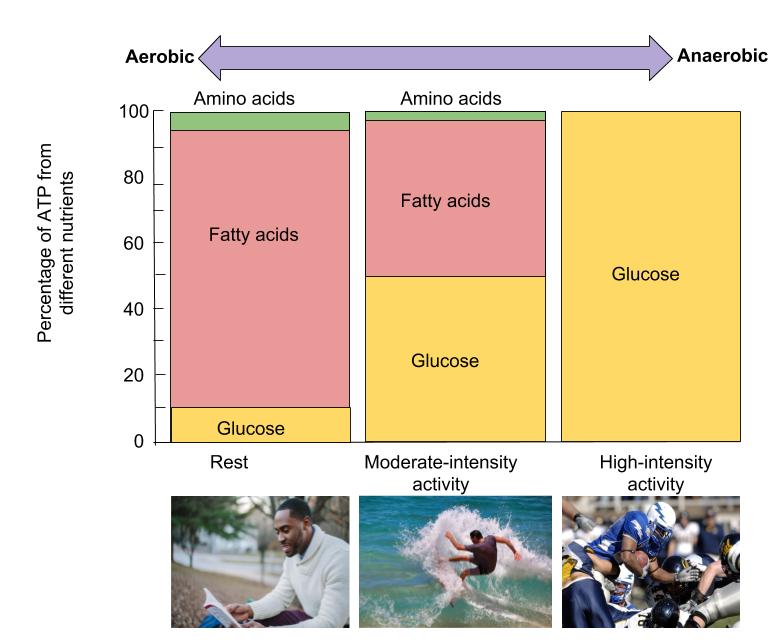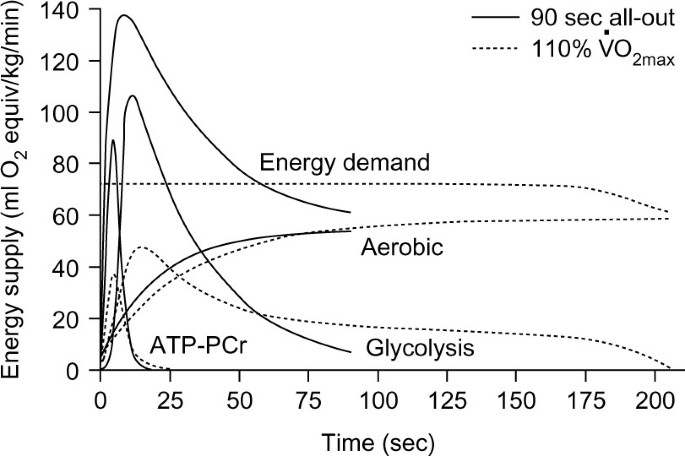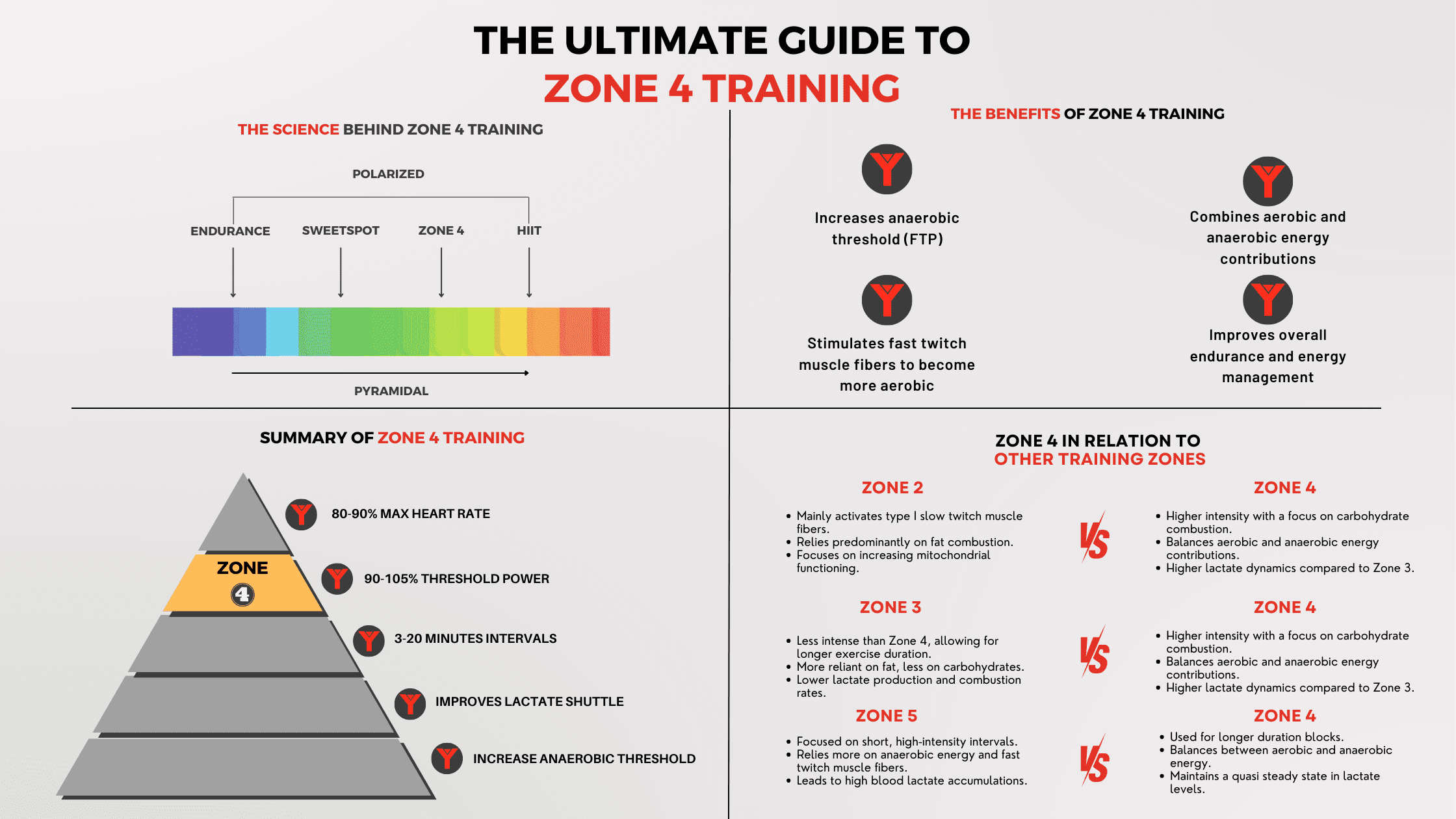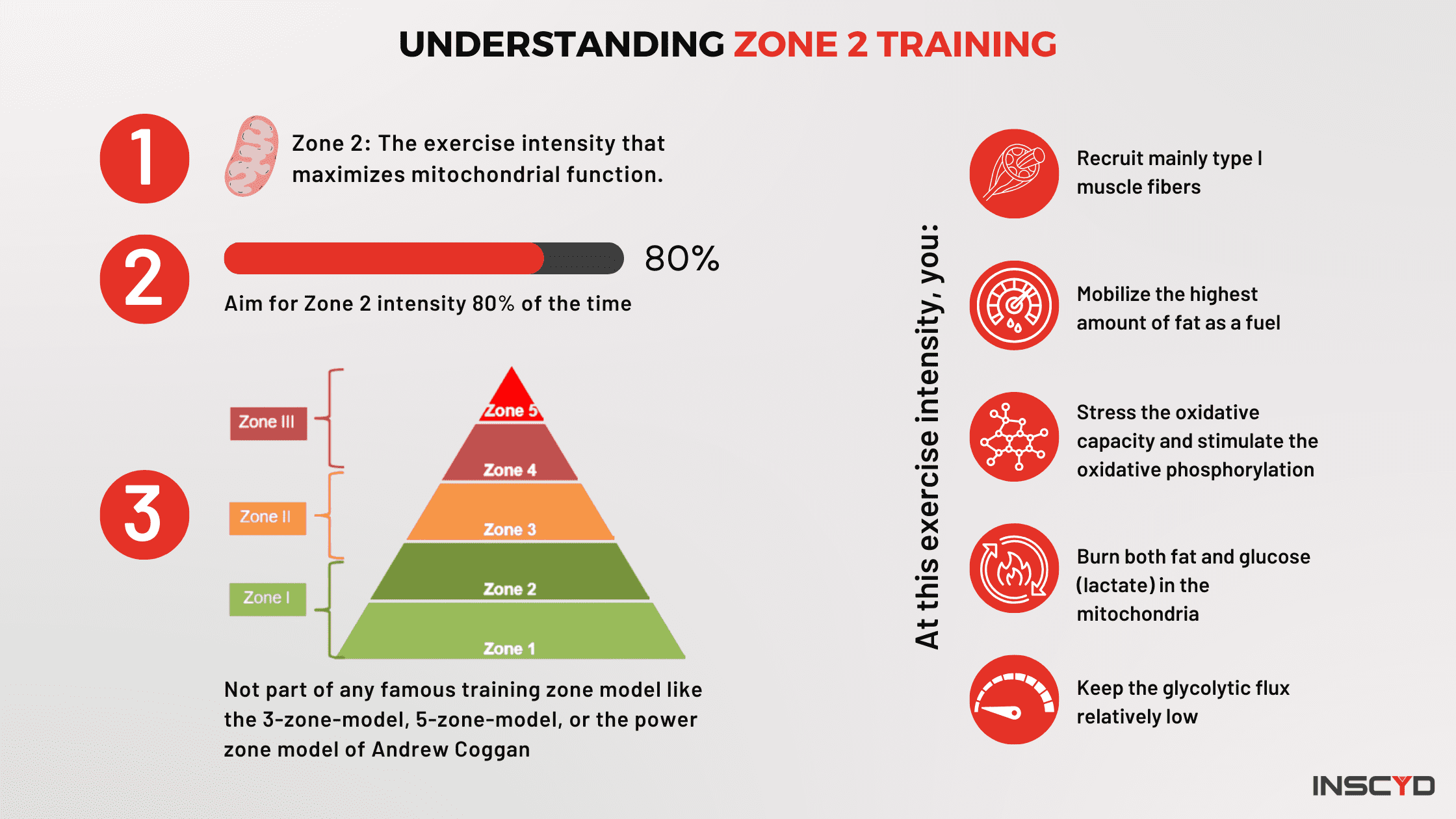Exercise Zone
| Five-level Target Zone | Age segmentation |
|---|---|
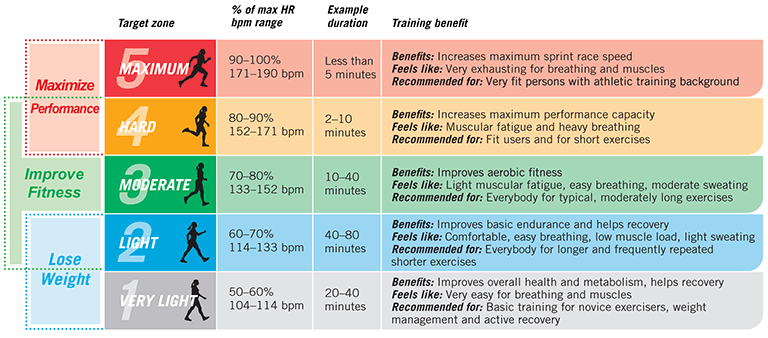 |
 |
VO2 Max: 最大摄氧量Anaerobic System:无氧系统Aerobic System: 帶氧系統Weight Control: 减脂Moderate activity适度活动
Energy system
- Anaerobic System
-
- 磷酸原系統 Phosphagen System (又称 ATP-CP System)
- 乳酸系統 Lactate System (又称醣解作用 Glycolysis)
- 有氧系統 Oxidative/Aerobic System
There are 3 Energy Systems: 1
ATP-CP
1. Anaerobic Alactic (ATP-CP) Energy System (High Intensity – Short Duration/Bursts)
Athletes who compete in sports that require high amounts of short duration intensity and acceleration will access this energy system.
The system does not use oxygen, but rather your body’s CP (creatine phosphate) stores to create energy for a short duration. Shot-putters, weight lifters, football players, gymnasts, sprint-distance runners, or any athlete that utilizes explosive movements will utilize this energy system.
Training this system through strength and power exercises prolongs the ability to maintain a higher intensity.
磷酸肌酸(Creatine Phosphate, CP),又称 磷酸肌酸(Phosphocreatine, PCr),是一种高能磷酸化合物,主要存在于 肌肉、脑和神经组织 中,作为 快速再生ATP的能量储备分子。
Anaerobic Lactic
2. Anaerobic Lactic (Glycolytic) Energy System (High to Medium Intensity – Uptempo)
The anaerobic lactic (AL) system (also known as fast glycolysis) provides energy for medium to high-intensity bursts of activity that lasts from 10 seconds to a max of approximately 90 seconds.
The ability to sustain this energy system is commonly viewed as an important athletic attribute in team sports such as basketball, hockey, ringette, and soccer, where shifts, or transitions, are a part of the game. Individual sports that consist of rallies or routines, such as tennis, figure skating, gymnastics, and skiing, utilize this system. Finally, there are several events within particular sports that rely almost exclusively on this energy system, such as rowing (500m), and middle distance runners (400m-800m).
The anerobic alactic system does not require oxygen, however, whereas the ATP-CP system will only produce energy for 10 seconds, fast glycolysis can work at a capacity for much longer.
As a result, waste products such as lactic acid accumulate in the blood and in muscle cells.
The burning sensation in the muscle, shortness of breath, and fatigue are all symptoms of lactic acid build up and thus impacts the athlete’s ability to perform. Focusing on this energy system during training can reduce the amount of lactic acid that builds up, and prolongs the ability to utilize this energy system, which results in a higher tempo and intensity.
- Anaerobic Lactic(无氧乳酸代谢) 和 Fast Glycolysis(快速糖酵解) 是同一代谢过程的两种名称,指细胞在 无氧或缺氧条件下 快速分解葡萄糖生成 乳酸(Lactate) 和 ATP 的途径。
Aerobic
3. Aerobic Energy System (Low Intensity – Long Duration – Endurance)
The aerobic system provides energy for low to medium-intensity activities that last anywhere from two minutes to a few hours. Any sport that has repeated shifts, rallies, events, or sustained exercise, such as long distance swimming, crew (rowing) and kayaking rely on the aerobic system.
Unlike the other two systems, the aerobic system requires oxygen and takes longer to overload and fatigue the system.
Training this system enhances the body’s ability to utilize oxygen, and allows an athlete to prolong the ability to sustain higher intensities before tiring and cramping out.
Summary: At any given time, each system is contributing ATP for exercise energy. However, the contribution of each system varies on the intensity and duration of the activity. The chart below summarizes the average energy system contribution during different sports.
三大能量系统的区别对比表
| 特性 | 磷酸肌酸系统 | 无氧乳酸代谢(Fast Glycolysis) | 有氧能量系统(Aerobic) |
|---|---|---|---|
| 能量来源 | 磷酸肌酸(CP)分解 | 葡萄糖/糖原无氧分解 | 葡萄糖、脂肪酸、氨基酸的有氧氧化 |
| ATP生成速率 | ⚡ 最快(瞬时供能) | ⚡ 快(但慢于CP系统) | ⚡ 慢(需多步骤反应) |
| ATP总量 | 极少(供能5-10秒) | 中等(供能30秒~2分钟) | 几乎无限(持续数小时) |
| 是否需要氧气 | ❌ 无需氧 | ❌ 无需氧 | ✅ 严格需氧 |
| 代谢终产物 | 肌酸(可循环利用) | 乳酸(部分堆积,部分回收) | CO₂ + H₂O(无害) |
| 主要应用场景 | 极限爆发力(如举重、短跑起跑) | 高强度短时运动(如400米跑、HIIT) | 耐力运动(如马拉松、骑行) |
| 恢复时间 | 2-5分钟(CP再合成) | 30分钟~2小时(乳酸清除) | 持续供能,无显著恢复期 |
| 关键酶/分子 | 肌酸激酶(CK) | 磷酸果糖激酶-1(PFK-1)、LDH | 柠檬酸合酶、细胞色素氧化酶 |
| 能量效率 | 1 CP → 1 ATP | 1葡萄糖 → 2 ATP | 1葡萄糖 → 30-32 ATP |
Three energy system in the body
Fuel Use During Exercise
* Amino acids : 氨基酸
* Fatty acids : 脂肪酸
* Glucose : 葡萄糖
- Phosphagen system : 磷酸原系统
- Glycolysis : 糖酵解
- pyruvate : 丙酮酸
- 在糖酵解结束时产生的丙酮酸(pyruvate)通常进入线粒体进入柠檬酸循环(citric acid cycle)
- Creatine Kinase : 肌酸激酶
- Krebs cycle : 克雷布斯循环
- 三羧酸循环(tricarboxylic acid cycle,TCA cycle)又称柠檬酸循环(citric acid cycle)、克雷布斯循环(Krebs cycle)
- phosphocreatine : 磷酸肌酸
20‑minute fat‑burning myth
the 20‑minute fat‑burning myth endures because it neatly packages complex exercise physiology into a simple, persuasive slogan—but it does not reflect how our bodies actually mobilize both fats and carbohydrates continuously throughout any bout of activity. Focusing on total caloric expenditure, exercise intensity, consistency, and overall lifestyle choices is a far more effective strategy for fat loss than waiting for a hypothetical “20‑minute switch.”
Energy Use During Exercise: A Time-Dependent Shift
- First Few Minutes (0-5 min):
- Body relies on ATP-PCr (phosphocreatine) system and anaerobic glycolysis (fast energy).
- Primary fuel: Muscle glycogen (stored carbs).
- 5-20 Minutes:
- Glycolysis dominates, still mostly using carbs (blood glucose + glycogen).
- Fat oxidation begins but remains low.
- After ~20 Minutes:
- Aerobic metabolism becomes dominant.
- Fat oxidation increases as glycogen depletes and adrenaline stimulates lipolysis (fat breakdown).
- muscle glycogen : 肌糖原
- glycolysis :糖酵解
- stored carbs : 糖原储备(专业术语,特指存储在肝脏和肌肉中的碳水化合物)
- Glycogen Depletion : 糖原耗尽
- adrenaline : 肾上腺素
- lipolysis : 脂肪分解
- Aerobic Metabolism : 有氧代謝
Why It Persists—and What Really Matters
-
Total Calorie Burn: Maximizing overall energy expenditure (through higher intensity or longer duration) drives greater fat loss than chasing a substrate‑use threshold Fitness Tutor.
-
EPOC (“Afterburn”): Intense workouts trigger excess post‑exercise oxygen consumption, burning additional calories—and fat—for hours afterward Fitness Tutor.
-
Consistency and Variety: A mix of intensities and durations prevents plateaus and overuse injuries, supporting long‑term adherence far better than rigid rules Verywell Fit.
substrate : 基板 · 基底
plateaus : 没有变化, 平稳期;停滞期, 稳定;停滞
Practice
Zone 4
EG. Outdoor Run:
AVE HR : 164 BPM
MAX HR : 173 BPM
AVE SPD: 5.32 mi/hr
ELV Gain: 86.32 ft
Twitch muscle fibers(肌纤维类型) 是指骨骼肌中根据收缩特性和代谢方式分类的不同肌纤维类型,主要分为:
-
慢肌纤维(Type I,慢缩肌纤维)
- 收缩速度慢,但耐疲劳性强,适合长时间、低强度的有氧运动(如马拉松、长跑)。
- 代谢方式:主要依赖有氧氧化(线粒体多,毛细血管丰富)。
- 颜色较红(因含有大量肌红蛋白)。
-
快肌纤维(Type II,快缩肌纤维)
- 收缩速度快,力量大,但易疲劳,适合爆发性、高强度运动(如短跑、举重)。
- 代谢方式:主要依赖无氧糖酵解(ATP生成快,但持续时间短)。
- 颜色较白(肌红蛋白较少)。
- 进一步细分:
- Type IIa(中间型):兼具一定耐力和力量,可经训练转化。
- Type IIx/b(纯快肌):爆发力最强,但最容易疲劳。
关键区别:
| 特性 | Type I(慢肌) | Type IIa(快肌-中间型) | Type IIx/b(快肌-纯爆发型) |
|---|---|---|---|
| 收缩速度 | 慢 | 快 | 极快 |
| 耐疲劳性 | 高 | 中等 | 低 |
| 主要代谢方式 | 有氧氧化 | 有氧+无氧 | 无氧糖酵解 |
| 适合运动类型 | 耐力运动 | 中高强度间歇训练 | 爆发力运动(如短跑) |
训练影响:
- 耐力训练(如长跑)可增强Type I纤维,甚至使部分Type IIa纤维变得更耐疲劳。
- 力量/爆发训练(如举重、冲刺)会促进Type II纤维增粗,提高力量和速度。
这些纤维的比例受遗传影响较大,但通过训练可优化其功能。
Zone 3
EG. Indoor Run:
AVE HR : 148 BPM
MAX HR : 160 BPM
AVE SPD: 5.26 mi/hr
ELV Gain: 0 ft
When comparing zone 2 and zone 3, zone 3 burns more calories, requires more aerobic and anaerobic power and activates more type II fast twitch muscle fibers.
Zone 2
EG. Elliptical:
AVE HR : 134 BPM
MAX HR : 157 BPM
**线粒体功能(Mitochondrial Function) **
指线粒体在细胞中执行的一系列关键生理作用,主要包括能量生成、代谢调节和细胞信号传导等。
线粒体功能异常的影响:
- 能量不足:疲劳、肌肉无力(如线粒体肌病)。
- 代谢疾病:胰岛素抵抗、糖尿病、肥胖。
- 神经退行性疾病:阿尔茨海默病、帕金森病(线粒体损伤导致神经元死亡)。
- 衰老:ROS积累加速细胞损伤。
如何优化线粒体功能?
- 运动:耐力训练可增加线粒体数量和效率(尤其激活 PGC-1α 通路)。
- 饮食:
- 间歇性禁食或热量限制可促进线粒体自噬(清除受损线粒体)。
- 补充 NAD+前体(如NMN)、辅酶Q10、抗氧化剂(维生素E、硫辛酸)。
- 避免毒素:酒精、重金属(如汞)会损伤线粒体。
氧化磷酸化(Oxidative Phosphorylation )
氧化磷酸化 OXPHOS 是细胞内有氧呼吸的最后一步,主要在线粒体内膜上进行,通过电子传递链(ETTP)和ATP合酶的作用,将NADH和FADH₂中的化学能转化为ATP(细胞的直接能量货币)。
葡萄糖 (Glucose)
- Glucose(葡萄糖)和 Lactate(乳酸)
糖酵解通量(Glycolytic Flux)
是指 葡萄糖在糖酵解(Glycolysis)代谢途径中的流动速率,反映了细胞分解葡萄糖生成丙酮酸(Pyruvate)及相关代谢产物的整体效率。
